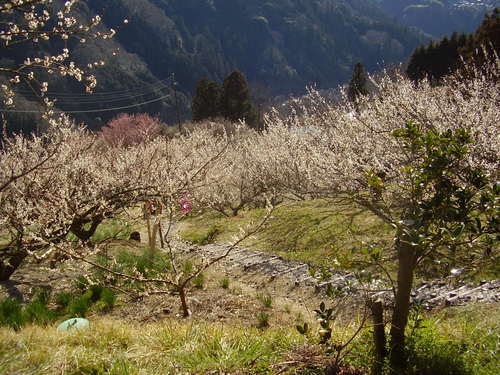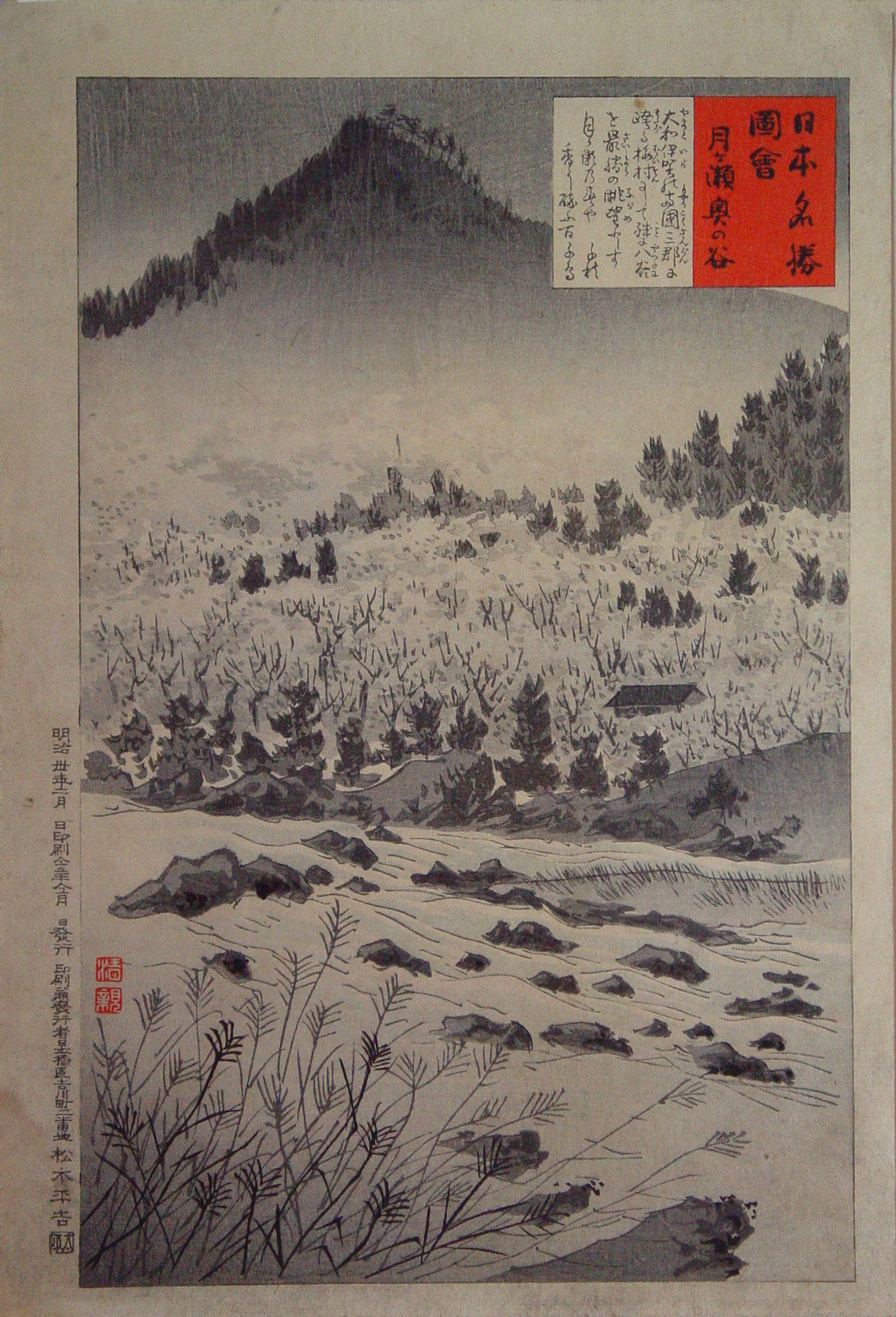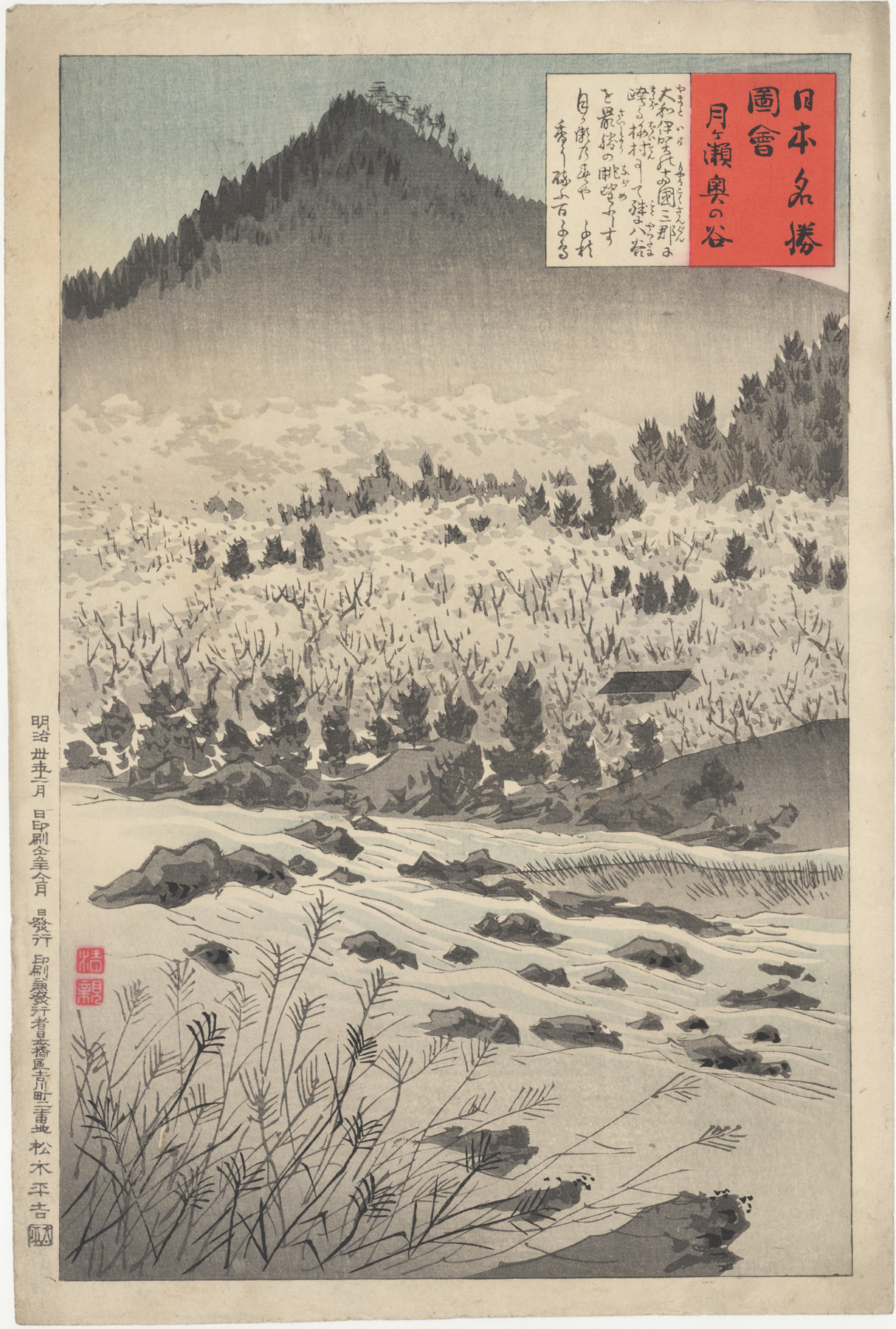About This Print
Number 191 of twenty-eight prints from the series Views of the Famous Sights of Japan (Nihon meishō zue) issued by the publisher Matsuki Heikichi in 1896 and 1897. (For additional information on this series see the article Views of the Famous Sights of Japan.) Two slightly different impressions of the same scene with a light blue replacing the grey sky.Source: Kiyochika Artist of Meiji Japan, Henry D. Smith II, Santa Barbara Museum of Art, 1988, p. 108-109.
This print depicts one of the most remote places featured in the series and a location that Kiyochika may have been unable to visit in person. It stands out as a particularly effective landscape in a series that overall is drab and uninspired. Perhaps Kiyochika was most inspired by places that he recreated from second-hand images and information.
This location is a secluded mountain valley whose fame for scenic beauty was relatively recent, unlike the more established “famous places” like Futamigaura, Togonoura, and Nikko. The discovery of newer sites of scenic beauty was the result of the enthusiasm among men of letters in the late Tokugawa (Edo) period (1603–1867) for traveling to remote places in search of beauty and history. The plum trees at Tsukigase were made famous in Travels in Plum Valley (Baikei yuki) of 1830 by the Confucian scholar Saito Setsudo.
The vast plum orchard that Kiyochika shows in Inner Valley at Tsukigase is located along both banks of the Naban River, the name for the Kizu River in its upper reaches in the mountains of the Kii Peninsula. Tsukigase (known locally as Tsukinose) is about ten miles due east of Nara along a stretch of the river running from east to west. Some ten thousand plum trees line both sides of the V-shaped valley for over two miles. The trees were planted in the precincts of a nearby temple in the late thirteenth century, and later propagated in great numbers as the source of a dye extracted from the plum fruits.
The sight of the thousands of plum trees blooming in February and March is spectacular, and the white blossoms fill the valley with a heady fragrance, noted in the haiku concluding the text:
Spring in Tsukigase:
Bush warblers
Drunk with fragrance.
(Tsukigase no haru ya ka ni you momochidori.)
Kiyochika’s print is remarkable for the coloring-or rather the absence of it. It is rendered almost completely in black sumi ink, which serves to heighten the sense of the whiteness of the blossoms; only the rushing waters of the Nabari River are shown in color, as streaks of subtle blue.
1 While unnumbered, this print is identified as #19 in the series by Smith in the above referenced work.
Tsukigase Ume-Plum Groves
Source: Naracity Tourist Association website http://narashikanko.jp/en/spots/kan_spot_data/e_si200.htmlThe ume trees in Japan blossom in early spring. The ume blossom always comes first, followed by peach, and then the cherry blossom. Thus, ume is a precursor to the following season, reminding us that spring is just around the corner. Tsukigase Valley is historically famous for its scenic beauty, with Satsuki River running through the center, and lots of ume trees covering the hillsides. Therefore, it is no wonder that Tsukigase was designated as a place of scenic beauty as early as 1923. Even today, many tourists come to enjoy the ume blossom in its peak season, strolling along the river banks or paths to Shinpuku-ji Temple or Ten-jinja Shrine. People naturally have warm feelings of affection toward these trees, which bloom so sweetly and proudly in beautiful natural settings every year.

Print Details
| IHL Catalog | #340; #1843 |
| Title or Description | Inner Valley at Tsukigase Tsukigase Okunotani 月ヶ瀬奥の谷 |
| Series | Views of the Famous Sights of Japan Nihon meishō zue 日本名勝図会 |
| Artist | Kiyochika Kobayashi (1847-1915) |
| Signature | unsigned |
| Seal |  |
| Publication Date |  |
| Publisher |  松木平吉 大平 [Marks: seal not shown; pub. ref. 029] |
| Impression | IHL Cat. #340: excellent IHL Cat. #1843: excellent |
| Colors | IHL Cat. #340: excellent IHL Cat. #1843: excellent |
| Condition | IHL Cat. #340: fair - paper soiling, one spot of foxing in cartouche, full margins, unbacked IHL Cat. #1843: good - paper soiling, particularly in margins; full margins; unbacked |
| Genre | ukiyo-e; meisho-e |
| Miscellaneous | Number 19 in the series |
| Format | vertical oban |
| H x W Paper | IHL Cat. #340: 14 1/2 x 9 3/8 in. (36.8 x 23.8 cm) IHL Cat. #1843: 14 3/8 x 9 1/2 in. (36.5 x 24.1) |
| H x W Image | IHL Cat. #340: 13 5/16 x 8 9/16 in. (33.8 x 21.7 cm) IHL Cat. #1843: 13 5/16 x 8 9/16 in. (33.8 x 21.7 cm) |
| Literature | Kiyochika Artist of Meiji Japan, Henry D. Smith II, Santa Barbara Museum of Art, 1988, p. 108, fig. 119 |
| Collections This Print | Los Angeles County Museum of Art M.71.100.95; Santa Barbara Museum of Art 1986.31.109; Hagi Yamaguchi Prefectural Museum U02638; Harvard Art Museums/Arthur M. Sackler Museum 1933.4.346; National Diet Library 寄別1-9-2-5 |



